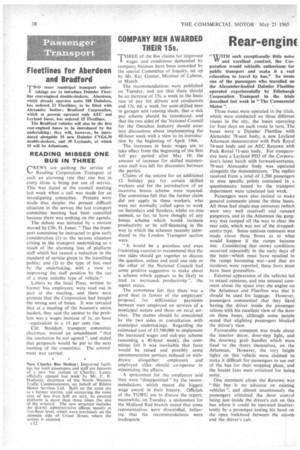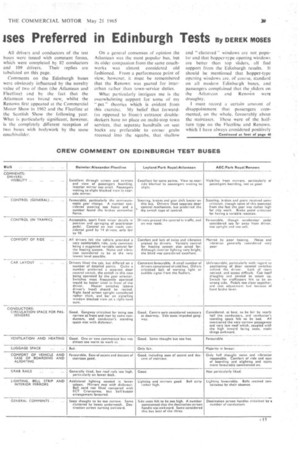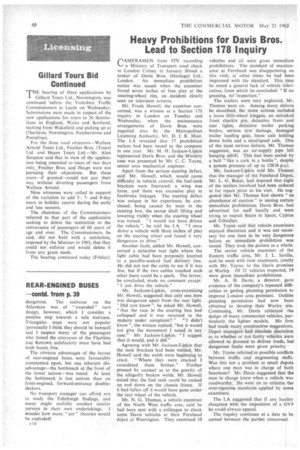"WITH such exceptionally little noise
Page 40

Page 41

Page 42

If you've noticed an error in this article please click here to report it so we can fix it.
VV and excellent comfort, the Corporation would rekindle enthusiasm for public transport and make it a real relaxation to travel by bus." So wrote one of the passengers who travelled on the Alexander-bodied Daimler Fleetline operated experimentally by Edinburgh Corporation Transport in the trials described last week in "The Commercial Motor ".
Three buses were operated in the trials, which were conducted on three different routes in the city, the buses operating for four days on each route in turn. The bases were a Daimler Fleetline with Alexander 78-seat body, a new Leyland Atlantean demonstrator with Park Royal 74-seat body and an AEC Renown with Park Royal 71-seat body. For comparative tests a Leyland PD3 of the Corporation's latest batch with forward-entrance, 70-seat Alexander body was operated alongside the demonstrators. The replies received from a total of 1,500 passengers to nine specific points contained in a questionnaire issued by the transport department were tabulated last week.
Passengers were also invited to make general comments about the three buses. All three had single-step entrances (which were very well received) and ramped gangways, and in the Atlantean the gangway was ramped all the way to clear the rear axle, which was not of the droppedcentre type. Some anxious comment was made about these floors as to what would happen if the ramps became wet. Considering that snowy conditions occurred repeatedly in the early days of the tests—which must have resulted in the ramps becoming wet—and that no incidents were reported, these fears must have been groundless.
External appearance of the vehicles led to mixed opinions, and one unusual comment about the space over the engine on the Atlantean and Fleetline was that it should be used for luggage. However, passengers commented that they liked having the driver inside the passenger saloon with his excellent view of the door on these buses, although some people noted that alighting passengers blocked the driver's view.
Favourable comment was made about the interior decor, door-step light, and the doorway grab handles which were fixed to the doors themselves, on the Atlantean. However, the very bright lights on this vehicle were claimed to make it difficult for passengers to see out of the bus for their stopping place, and the heater fans were criticized for being noisy.
One comment about the Renown was "this bus is no advance on existing vehicles ", and almost unanimously the passengers criticized the door control being just inside the driver's cab on this bus where it could be operated inadvertently by a passenger resting his hand on the open bulkhead between the saloon. and the driver's cab.
MI drivers and conductors of the test buses were issued with comment forms, which were completed by 82 conductors and 109 drivers. Their replies are tabulated on this page.
Comments on the Edinburgh buses were obviously influenced by the novelty value of two of them (the Atlantean and Fleetline) and by the fact that the Atlantean was brand new, whilst the
• Renown first appeared at the Commercial Motor Show in 1962 and the Fleetline at the Scottish Show the' f011owing year. What is particularly significant, however, is the completely different reception of two buses with hoclyWork by the same coach builder.
On a general consensus of opinion the Atlantean was the most popular bus, but its older companion from the same coachworks was almost considered old fashioned. From a performance point of view, however, it must be remembered that the Renown was geared for interurban rather than town-service duties.
What particularly intrigues me is the overwhelming support for some of my " pet" theories which is evident from this exercise. My belief that forward(as opposed to front-) entrance doubledeckers have no place on multi-stop town services, that separate handrails on seat backs are preferable to corner grabs recessed into the squabs, that shallow
and "cluttered" windows are not popular and that hopper-type opening windows are better than top sliders, all find support from the Edinburgh results. It should be mentioned that hopper-type opening windows are. of course, standard on all modern Edinburgh buses, and . passengers complained that the .sliders on the Atlantean and Rcnown were draughty.
must record a certain amount of disappointment that passengers commented, on the whole, favourably about the staircases. These were of the halfturn type on the Fleetline and Renown. which I have always considered positively
R EAR-ENG I NED BUSES —contd. from p.39
dangerous. The staircase on the Atlantean was of "extended " turn design, however, which I consider a positive step towards a safe staircase. Triangular steps were not popular (personally I think they should be banned) and I suspect many of the passengers who found the staircases of the Fleetline and Renown satisfactory must have had both hands free.
The obvious advantages of the layout of rear-engined buses were favourably commented upon, but one inherent disadvantage—the bottleneck at the front of the lower saloon—was noted. At least the bottleneck is less serious than on front-engined, forward-entrance doubledeckers.
No transport manager can afford not to study the Edinburgh findings, and many might usefully conduct similar surveys in their own undertakings. I wonder how many " pet " theoriei would he exploded!
c14
























































































































